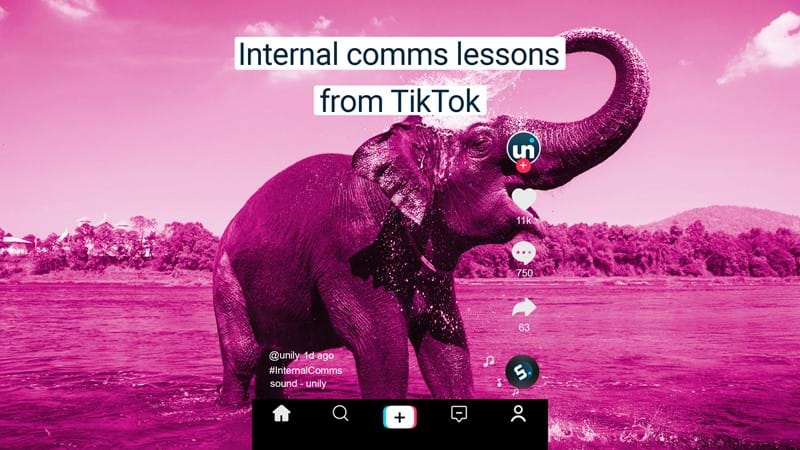How to combat employee engagement fatigue with technology
In times of change and disruption, the need for transparent communications intensifies but when updates become overwhelming there's a danger that employees will switch off. Learn how to spot the signs of engagement fatigue and use technology to beat burnout.

Understanding employee engagement fatigue
When enterprises undergo periods of intense change and disruption, engagement levels can suffer. Constant communications are needed to keep employees informed, but when the updates become overwhelming burnout can set in. If left unchecked information overload will result in a disengaged workforce that damages business performance. So how can you fix it?
Research tells us that engaged employees are a company's greatest asset - and when the going gets tough, motivated employees are needed more than ever. The equation is simple: the more engaged people, the more resilient and innovative your business.
"2020/21 saw the most significant drop in employee engagement since 2000."
Engaged employees are more productive, better informed, and more likely to go the extra mile when the need arises. On the flip side, fatigued employees are more likely to take time off, underperform, and eventually exit the business taking their expertise with them. Hubspot research shows that a drop in employee productivity costs the average enterprise around USD 1.8 billion dollars annually.
According to new figures, 2020/21 saw the most significant drop in employee engagement since 2000. With this in mind, it's vital that business leaders get savvy when it comes to spotting and reversing the signs of engagement fatigue to ensure smooth sailing in the years ahead. For internal communicators to re-energize the workforce, they require a fresh approach and the right tools to prime engagement.
"What we’re experiencing is the result of having an immense need to communicate large volumes of information very quickly, while also responding to very rapid organizational change in response to the pandemic. The communication load has been huge but has unfortunately caused an attention deficit for many."
To support internal communicators wrestling with the challenge of engagement fatigue, we teamed up with Jen Sproul, Chief Executive at the Institute of Internal Communication, to uncover the latest insights and advice on how businesses can best re-engage their employees for the long run. The hour-long session was packed full of advice, tips, and best practices for organizations to overcome employee engagement fatigue and we've summarized the best bits below.
4 tips to regain employee attention with enterprise technology
When you spot the signs of engagement fatigue, it's important to act fast and use every tool at your disposal to revive employee morale. Enterprise technology is a powerful weapon for combatting employee engagement challenges and in times of disruption, you need to know how to use it to its full potential and avoid the common pitfalls.
#1. Move from reactive to strategic as soon as possible
When big changes are afoot it can be tempting to fire out messages in an ad hoc fashion. Sometimes this is necessary, but if the approach persists for too long the results are counterproductive. Constant updates can add to feelings of uncertainty and turbulence. As soon as it's feasible, enterprise communicators need to move from reactive to strategic. Take a step back and think about how you can break messaging down into manageable updates that drip-feed over time.
Set up an information hub to give employees more agency
Having a single place, like a dedicated site or page on your company intranet, will mean that employees know where to go for updates when they're ready to receive them. Giving employees a way to take in information at their own pace is a cunning way of delivering key messages without overwhelming the workforce.
Top tip: Ensure your content is appropriately tagged and categorized so employees can search for it easily using your intranet search function.
Lean into engagement automation
Engagement automation is a new tool that internal communicators can lean on to manage complex communication scenarios. External marketers have used campaign building and automation technology to promote customer engagement for years: creating complex workflows that drip-feed information to customers based on their preferences and behaviors. It allows them to deliver more personalized, timely communications that meet consumers on preferred channels and times they're most primed to engage. Now internal communicators can do the same.
Unily's engagement automation feature lets enterprise communicators plan, schedule, automate and track complex communications campaigns across multiple channels. When it comes to adopting a strategic mindset, having clear goals and ways to measure success is essential. Engagement automation lets you do just that. When managing change, this type of automation offers a huge advantage, enabling updates to be fed at a manageable pace without the need for constant monitoring by enterprise communicators.
"As organizational change is becoming more standardized, it’s become more important to not just think about task-based comms. Set an objective around employee engagement – whether that engagement is with a new product launch, or you want people to spend two weeks really thinking about their mental health and wellbeing. It’s about the campaign mindset – how do you send the right comms to the right people at the right time? This then leads to higher engagement as you hit the right touchpoints within your business."
#2. Choose the right channel for the right message
As a result of the shift to remote working and the sudden demand for employee communications, many enterprises now have an array of channels to reach employees with meaningful comms. Aside from the issues, this creates productivity and business siloes which means communicators now have more choice when it comes to connecting with employees.
"Think about how you can build your communication into the flow of everyone’s day, rather than making it an additional aspect. Take what your content is and put it onto different lenses of what you want to achieve. Build the information into your employee’s day through the intranet."
Understanding the benefits of each channel, and how to leverage them to support your strategy is vital to navigating channel complexity. Some key channels to consider include:
Social channels
Social channels are a great way to encourage engagement and nurture communities through conversation, making employees feel valued and listened to. They are an excellent place to disseminate information, heavily encourage the employee voice, and can encourage more of the workforce to join in with the conversation.
Mobile
For remote, hybrid, and frontline workers, a mobile channel can be the most effective way of communication. Push notifications can give immediate updates in a timely manner, putting the most important information in the hands of those that need it.
Video
Video technology can be used to humanize the message and create compelling content that every end-user will want to watch. Whether it’s to deliver leadership comms, employee updates, or business news, video can capture attention through visuals. Putting a face to the message also increases trust and creates a shared sense of purpose.
Feedback forms
An important part of communication is two-way dialogue, and so you should be considering how to open this up through your channels of communication. Having the option for employees to provide feedback on messages and updates through features such as forms can be a great way to see how your workforce is engaging with the news. Polls are also a simple but effective feature to gather instant feedback on the employee experience.

Email broadcast
Although email is usually the one medium that many organizations feel is overused, if used effectively, it can be a way to directly reach an employee quickly. A Broadcast Center will assist with streamlining the distribution of content across multiple channels, bringing all the capabilities of specialist email building tools into one place, and simplifying processes for your content creator ensuring each message gets to its recipient instantly.
Chatbots
If the information you are putting out doesn't need to be communicated immediately, chatbots can be a great way of reducing the time spent answering simple and repetitive queries. It not only streamlines making finding information easier but also contributes to improving the employee experience by making it more interactive.

#3. Keep your comms short, snappy, and accessible
No matter which channel, to avoid fatigue the comms you deliver need to be short and snappy. Our habits as consumers now revolve around streaming content in a bite-sized approach. The average person’s attention span fell from 12 seconds in 2000, to 8 seconds in 2021.
"Video is the most used channel of 2020 and it was the fundamental go-to. It humanizes, but the content and what you are creating still needs to be accessible. Our consumer habits include Netflix, streaming, and a bite-sized approach. We are going to see an increase in video but it still needs to be accessible. We need to make sure our creative energy and thinking is put into enabling great communication."
Think about how workers needs and preferences differ
ICs should be tailoring content to be concise and easy for everyone to consume. Accessibility also plays a huge part in this. For video content, think about providing subtitles. Is your workforce global? Make sure your content is multilingual. Technology can be used to make sure communications are delivered effectively to all, and ICs should be making the most of it.
#4. Give your employees a voice
To effectively manage business change and understand the implications on employee morale, the conversation should be two-way. Empowering your employees to have a say and a voice lets you keep the pulse on reactions to change. When we feel our opinions are valued and we have an outlet to express them, disruption feels more manageable.
Most modern intranets will include features like feedback forms, polls, pulse surveys, and quizzes that can help you gauge employee mood and ensure understanding of key policy updates. Pulse surveys are a powerful tool to glimpse worker experiences in real-time, without disrupting workflows and productivity. They can be disseminated to certain segments of your workforce, honing in on the specific groups you most want feedback from. Feedback forms and quizzes can also offer business leaders reliable and repeatable sources of data and employee comprehension whenever they need it.
Win the battle for employee attention
The tips above are just some of the best practices that were shared in our hour-long webinar in partnership with IOIC. To get the full lowdown, check out the on-demand recording while it's still available!
To find out more about how a modern intranet can transform internal communicators or for more information on how Unily primes engagement for the world's largest workforces, contact us today.




















